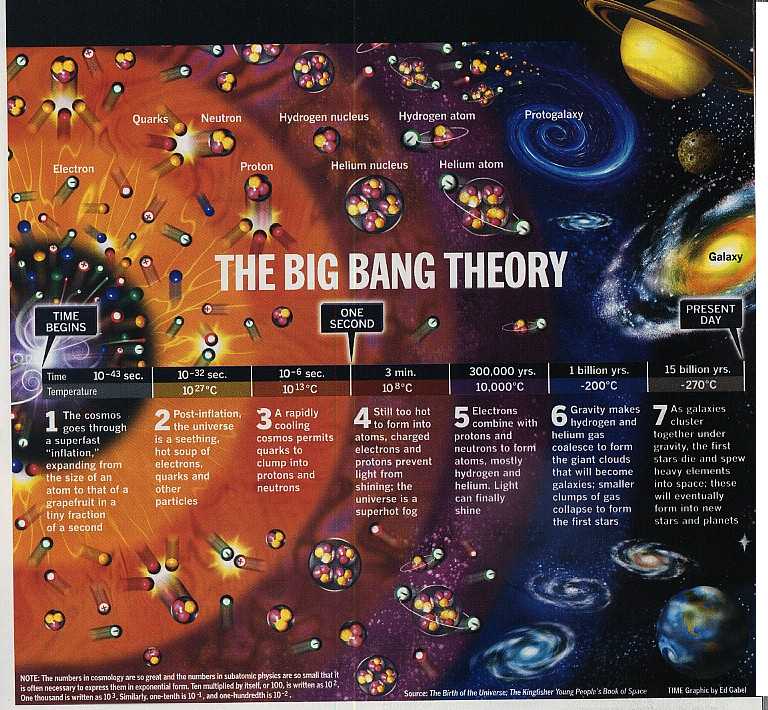THE BIG BANG[]
Big Bang Theory - The Premise The Big Bang theory is an effort to explain what happened at the very beginning of our universe. Discoveries in astronomy and physics have shown beyond a reasonable doubt that our universe did in fact have a beginning. Prior to that moment there was nothing; during and after that moment there was something: our universe. The big bang theory is an effort to explain what happened during and after that moment.
According to the standard theory, our universe sprang into existence as "singularity" around 13.7 billion years ago. What is a "singularity" and where does it come from? Well, to be honest, we don't know for sure. Singularities are zones which defy our current understanding of physics. They are thought to exist at the core of "black holes." Black holes are areas of intense gravitational pressure. The pressure is thought to be so intense that finite matter is actually squished into infinite density (a mathematical concept which truly boggles the mind). These zones of infinite density are called "singularities." Our universe is thought to have begun as an infinitesimally small, infinitely hot, infinitely dense, something - a singularity. Where did it come from? We don't know. Why did it appear? We don't know.
After its initial appearance, it apparently inflated (the "Big Bang"), expanded and cooled, going from very, very small and very, very hot, to the size and temperature of our current universe. It continues to expand and cool to this day and we are inside of it: incredible creatures living on a unique planet, circling a beautiful star clustered together with several hundred billion other stars in a galaxy soaring through the cosmos, all of which is inside of an expanding universe that began as an infinitesimal singularity which appeared out of nowhere for reasons unknown. This is the Big Bang theory.
Big Bang Theory - Common Misconceptions There are many misconceptions surrounding the Big Bang theory. For example, we tend to imagine a giant explosion. Experts however say that there was no explosion; there was (and continues to be) an expansion. Rather than imagining a balloon popping and releasing its contents, imagine a balloon expanding: an infinitesimally small balloon expanding to the size of our current universe.
Another misconception is that we tend to image the singularity as a little fireball appearing somewhere in space. According to the many experts however, space didn't exist prior to the Big Bang. Back in the late '60s and early '70s, when men first walked upon the moon, "three British astrophysicists, Steven Hawking, George Ellis, and Roger Penrose turned their attention to the Theory of Relativity and its implications regarding our notions of time. In 1968 and 1970, they published papers in which they extended Einstein's Theory of General Relativity to include measurements of time and space.1, 2 According to their calculations, time and space had a finite beginning that corresponded to the origin of matter and energy."3 The singularity didn't appear in space; rather, space began inside of the singularity. Prior to the singularity, nothing existed, not space, time, matter, or energy - nothing. So where and in what did the singularity appear if not in space? We don't know. We don't know where it came from, why it's here, or even where it is. All we really know is that we are inside of it and at one time it didn't exist and neither did we.
Big Bang Theory - Evidence for the Theory What are the major evidences which support the Big Bang theory?
- First of all, we are reasonably certain that the universe had a beginning.
- Second, galaxies appear to be moving away from us at speeds proportional to their distance. This is called "Hubble's Law," named after Edwin Hubble (1889-1953) who discovered this phenomenon in 1929. This observation supports the expansion of the universe and suggests that the universe was once compacted.
- Third, if the universe was initially very, very hot as the Big Bang suggests, we should be able to find some remnant of this heat. In 1965, Radioastronomers Arno Penzias and Robert Wilson discovered a 2.725 degree Kelvin (-454.765 degree Fahrenheit, -270.425 degree Celsius) Cosmic Microwave Background radiation (CMB) which pervades the observable universe. This is thought to be the remnant which scientists were looking for. Penzias and Wilson shared in the 1978 Nobel Prize for Physics for their discovery.
- Finally, the abundance of the "light elements" Hydrogen and Helium found in the observable universe are thought to support the Big Bang model of origins.
